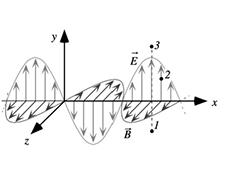
Electromagnetic waves
Variant i Dynamics first
Students interpret a commonly used representations of an electromagnetic plane wave and examine how an antenna detects electromagnetic waves. They relate Faraday’s law to EM waves.
Topics Waves and optics / Physical optics: models, representations, vectors, frequency & wavelength, and wave (or pulse) speed
Materials
Materials by the UW team
- Group Handout


- Instructor Guide


- Pretest


- Exam Questions



- Equipment List

Tutorial details
The tutorial begins with some of the same questions as on the pretest. Students are given the diagrammatic and algebraic representations and asked to determine the direction of propagation of the wave and rank four points according to (1) the magnitude of the electric field and (2) the magnitude of the magnetic field. Few students spontaneously recognize that the algebraic representation can be used to determine that the electric field is the same at points that have the same x coordinate but different z coordinates. Students are led to recognize that for a plane electromagnetic wave, the electric (and magnetic) field is the same at all points in a plane perpendicular to the direction of propagation. Students then interpret diagrammatic representations of EM waves that have different amplitudes and wavelengths.
In the next part of the tutorial, students are guided to understand how a wire can be used to detect an electromagnetic wave. In the final part of the tutorial, students are led to relate Faraday’s law to an EM wave. They use Faraday’s law to argue that it is not possible to have the same electric field as discussed above with a magnetic field that is zero for all x and t.
For instruction tips, login or register as a verified educator to see the Instructor Guide.
Prerequisites
It is expected that students have studied some electricity and magnetism. In particular, they must be familiar with the Lorentz force equation and Faraday’s law. The last page of the tutorial may be difficult for students with weak backgrounds in mathematics.
Equipment
Special Instructions
Handouts
- 6 copies of diagram showing representations for an EM wave. (See Handouts.)
Optional: 6 three-dimensional representations of an EM wave. (See Handouts.)
List
- handouts
- white board or large sheet of paper with markers
Research
- B. Ambrose, P. Heron, S. Vokos, and L. McDermott, Student understanding of light as an electromagnetic wave: Relating the formalism to physical phenomena, Am. J. Phys. 67 (10), 891 (1999).
Coming Soon! We hope to release the discussion section on each tutorial soon.

